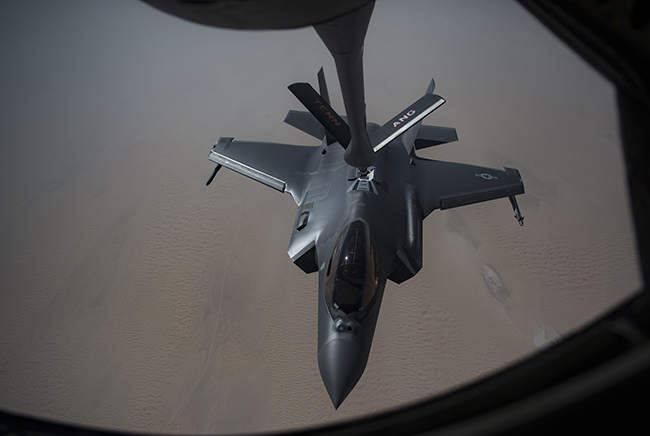
An airman piloting an F-35A Lightning II receives fuel from a KC-135 Stratotanker from the 28th Expeditionary Aerial Refueling Squadron, May 12, 2019, at an undisclosed location. Air Force photo by SrA. Keifer Bowes.
House appropriators boosted the Air Force’s fighter procurement plans in their version of the fiscal 2020 defense spending bill, adding 12 F-35As on top of the Pentagon’s request and funding the start of the F-15EX program.
The House Appropriations Committee this week released a summary of the $690.2 billion Defense Department funding legislation, which the defense subcommittee will consider May 15. The topline figure is $8 billion lower than the Trump administration’s 2020 request. Military construction funding is covered under a separate appropriations bill.
Lawmakers propose spending $8.7 billion on 90 Lockheed Martin F-35s, as well as $986 million on eight Boeing F-15EX aircraft to replace older F-15C and D jets. That decision comes amid concern on Capitol Hill that the Air Force is shortchanging its F-35 buy plan to invest in a fourth-generation jet that wouldn’t stand up in future combat environments. (See also: F-15EX vs. F-35 in the May issue of Air Force Magazine.)
A committee spokesman confirmed the House bill fulfills part of the Air Force’s 2020 wish list, which asked for another dozen F-35As in addition to the 48 included in the budget it submitted in March. Lawmakers also want to fully fund continued development of the Joint Strike Fighter’s Block 4 upgrades, to the tune of $1.5 billion. Block 4 mostly consists of software changes and should improve electronic warfare capabilities, radars and electro-optical systems, logistics, interoperability, navigation, and the weapons magazine.
The bill includes language that would block Turkey from receiving the F-35 as the country plans to purchase Russian S-400 air defense systems.
Notably, the bill text also allows the Defense Department to use $15 million to study and refine its plans for a potential Space Force, but stops short of endorsing its creation as a sixth service within the Air Force. It also blocks DOD from spending any funding to transfer personnel, property, or resources to the Space Force.
“Nothing in this provision shall be construed to authorize the establishment of a Space Force,” the bill states.
Another $3 billion would further the secretive B-21 bomber development program at Northrop Grumman following its successful critical design review. Lawmakers also added four Air Force Reserve C-130Js to a $1.4 billion spending plan for various configurations of the aircraft, for a total of 16 C-130Js, MC-130Js, and KC-130Js.
For space programs, appropriators offer the Air Force $1.2 billion to buy four launches under the National Security Space Launch program. Further details about the bill’s content will be revealed when the full committee takes up the legislation.
“The subcommittee has sought throughout this legislative process to keep in mind the morale and the quality of life of all of our service members and their families,” subcommittee Chairman Rep. Pete Visclosky (D-Ind.) said in a release. “I believe we have taken tangible steps in this bill to refocus much-deserved attention on their issues of concern.”
He noted lawmakers hope to get a defense appropriations bill signed into law by the end of September to avoid a continuing resolution for the military, which would block new-start programs and limit munitions buys, among other effects.
The Democrat-controlled committee rejected the Trump administration’s attempt to circumvent the annual spending cap, which would limit defense spending to $576 billion in 2020 unless lawmakers cut a new deal, by offering $68 billion for overseas contingency operations rather than the requested $173.8 billion. Defense officials asked for nearly $98 billion in “OCO to base” funding that would not have been subjected to the budget caps set in 2011, though OCO is meant to pay for the less-predictable annual costs of war.
The proposal includes $154 billion for military personnel to fund an Active Duty end strength of 1,337,500, or 2,000 fewer than requested and 600 below the current level. Another $256.5 billion would go toward operations and maintenance, $142 billion toward procurement, and $101.5 billion toward research and development.
To the Air Force, the bill offers $37.1 billion for Total Force military personnel spending, $54.7 billion for operations and maintenance, $45.7 billion for procurement, $44.8 billion for research and development, and about $16 billion in OCO funds.
After months of debate over whether the Pentagon should redirect funds to pay for troops and a barrier at the nation’s Southern border, House appropriators also blocked DOD from using defense dollars to pay for a wall and slashed the amount of money the department can ask to internally transfer from $9.5 billion to $1.5 billion.
“The bill ensures that our service members are trained and equipped to do their jobs safely and effectively and that they are prepared for future military needs,” committee Chairwoman Rep. Nita Lowey (D-N.Y.) said in a release. “This bill honors their mission by adequately funding programs to care for service members and their families, and by protecting defense funding from being stolen for the President’s wasteful wall.”